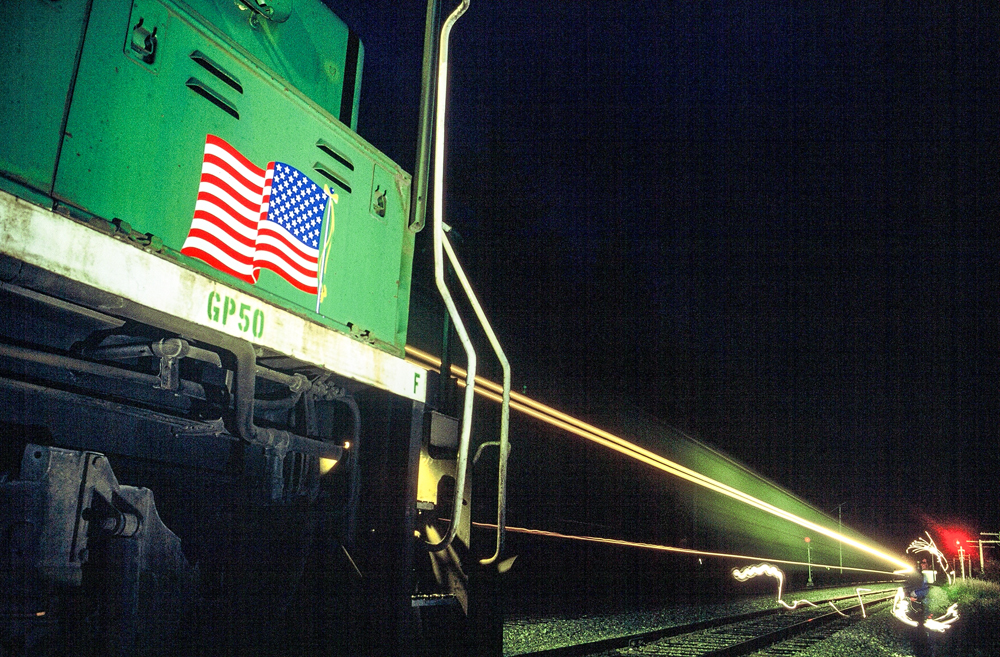Railroad fusees

My first memory of using railroad fusees [flares] for signaling was on an early winter morning in 1978. Coming back from lunch on the midnight shift at Auburn yard, the scenery had turned very foggy. Lanterns, while not useless, were hard to see at a distance in that kind of weather.
During those days, we normally only had one portable radio per crew. The foreman on the switch job had the radio; that way the yardmaster could make a change to the switch list when needed. The fieldman would borrow the radio from the foreman when hand signals could not be used due to the distance.
At Auburn, when the fieldman got the whole train together, they would throw the fusee into the air as high as they could signaling to the rest of the crew that the track was together — this was in lieu of borrowing the radio.
I joined the naval reserves in 1983 near the end of a three-year furlough from the railroad. I returned home from active duty after graduating from the U.S. Naval Schools of Photography in Pensacola, Fla., summer of 1984 as a Photographer’s Mate.
I didn’t have any good railroad options for working near Seattle, so I ended up moving to Spokane in eastern Washington. One night I was working the fieldman position at Yardley. After I had the track together, I threw the fusee as high as I could. I heard the air go, meaning the engineer had placed the train brakes into emergency, and everything came to a stop. The foreman marched down to where I was. He was upset wanting to know why I gave him the washout, thus his emergency stop. I said that I gave a highball — so he asked where I was from.
“Ah, right, you’re one of those Coasties. Well, that has exactly the opposite meaning in Spokane,” he said. Which I found interesting, considering both were Northern Pacific yards.
On my first solo trip as an engineer on the Mojave Subdivision out of Bakersfield, my conductor got a late call. I was standing around the yard office when the road foreman came up to me and told me to keep an eye on this guy, he was a little different. Nice kid; I do not recall the trip until we were between the siding of Jimgray and Hinkley on the old ATSF to Barstow.
The dispatcher (DS) called and said, “I want you to pull in the clear; you are going to have to cut the crossing.” Hinkley was the last siding eastbound before the hump yard at Barstow. As we started into the siding my conductor pulled the emergency brake handle on his side. I looked over in disbelief. He was not happy about the long wait. He explained that this way the DS could wait. I didn’t even bother to rip him apart about what trains can do when they go into emergency. I was just trying to get the first solo trip over with.
After I recovered the air, we pulled into the clear and cut the crossing as instructed. After a 2-hour wait, the DS called and said it was our turn. My conductor could not find his lantern. The head end of the trains was about 30 car lengths over the crossing, so I was not going to see his hand signals in the dark. We would have to use fusees.
I told him to light up the fusee, while I whistled three times to show I would be slowly starting back. I had told him to give me two big circles at ten cars and one circle for five cars, then the normal signs for 4-3-2-1-stop. We had the train back together. As he was walking back up to the lead unit, I saw him in my mirror and noticed he was walking weird. He had both arms out from the shirt’s shoulders with his arms hanging down, like a sad scarecrow.
As he got back into the cab, I looked over at him with part concern and part amusement — he had peppered himself with the slag of the burning fusee. As he stood there, he had a dozen or so tiny holes in each arm still smoldering.
He had never used a fusee and was waving it around like a lantern. When I figured out the only thing hurt was his pride and his brand-new coat from his wife, it took everything I had to not bust out laughing. Ah, karma. Highball.
Like this column on railroad fusees? Read the last one, “An engineer’s life: Mojave Green.”














In another world it’s interesting to see a Navy guy called a “Coastie.”
Don’t forget the use of torpedoes strapped to the rails in advance of fusees, red flag or and obstruction, to warn trains of danger and be prepared to stop.
Mike Lusk Western Pacific RR
You are absolutely correct. I can tell you also that 20 torpedoes in a lunch bag does in fact bolw a knuckle off a freight car. 😎